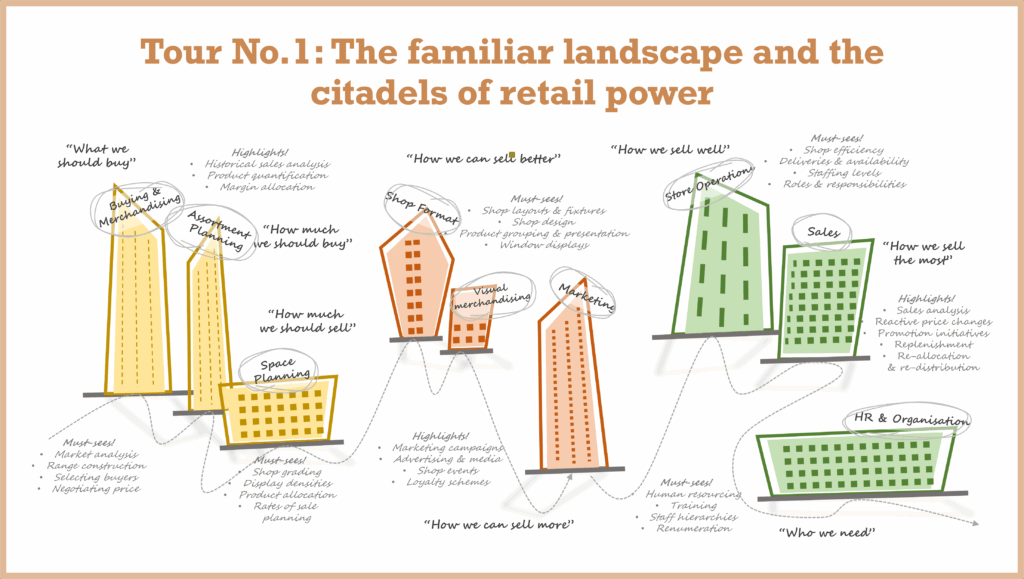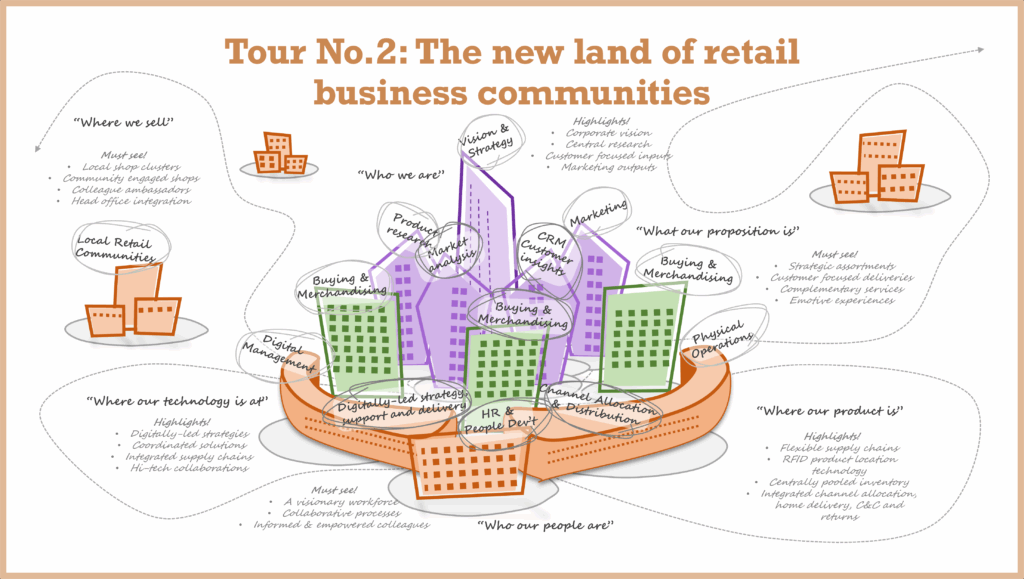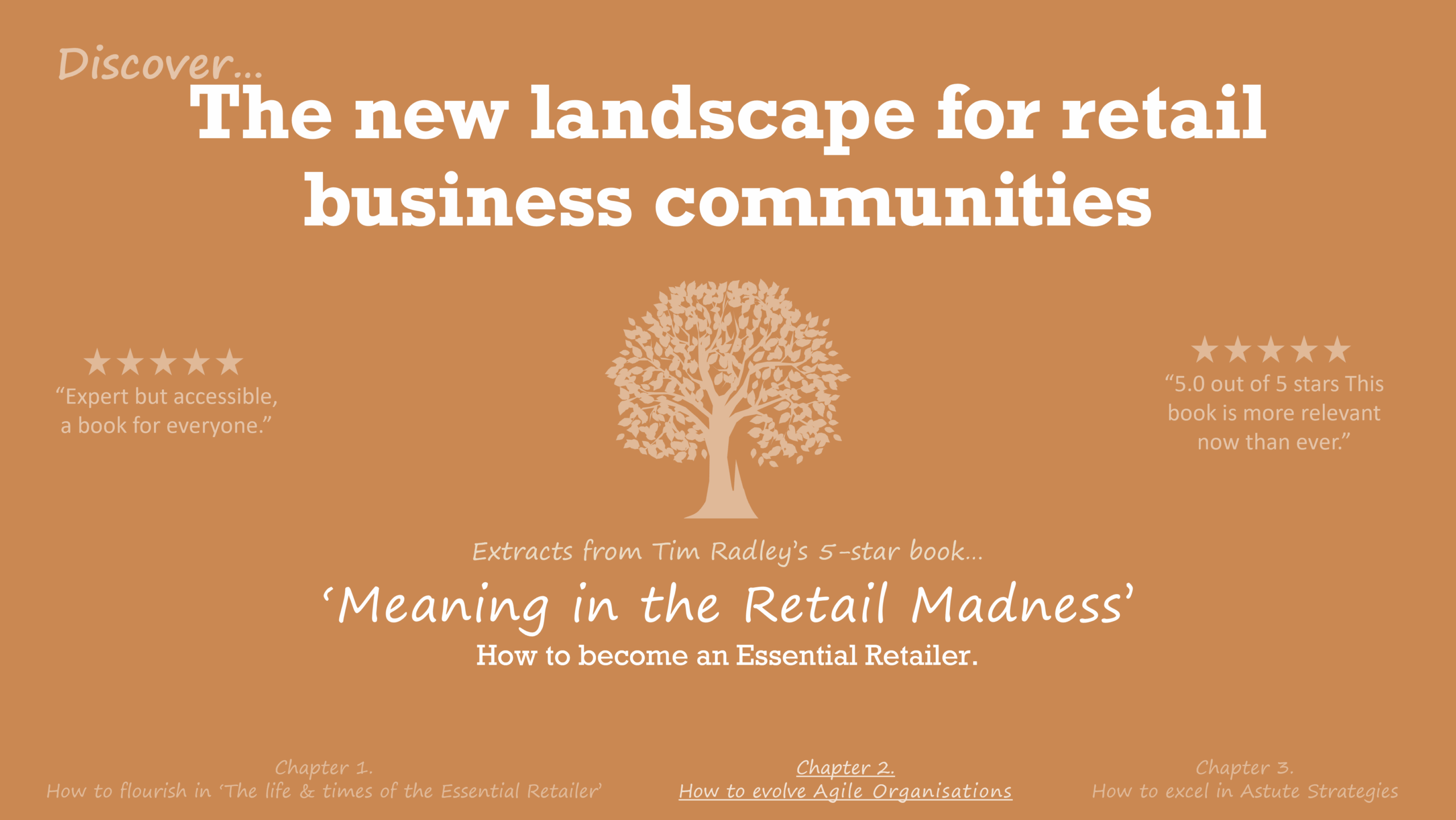Extracts from Tim Radley’s 5-star book…
‘Meaning in the Retail Madness’
How to become an Essential Retailer.
If we were retail tourists, planning a ‘grand tour’ of a best practice retail organization, then the itinerary we would plan today would be very different from the schedule we would have travelled even ten years ago.
In those relatively recent but otherwise distant times, the journey would have been straightforward in every sense. We would have followed a linear route that visited all the important retail departments, all the ‘tour highlights and must-sees’ in order, and independent of each other.
We would have followed a path through the business functions that replicated the journey of the product, from buying to selling.
Tour No.1: The familiar landscape and the citadels of retail power
The familiar ‘Ivory Towers’ of traditional retail businesses reflect the ‘Age of Discovery’ in the history of retail evolution. This was the time of demand led markets and limited competition.
Product was king. Buyers were the kingmakers.
Naturally enough, the organisational structure and processes of many retailers are still built around the familiar product functions – buying, sourcing, merchandising and space allocation. Until recently, the drivers of profit related directly to how much product you could put into every square metre of your shops, and the initial and realised margins you could buy and sell your products for. To a greater or lesser extent, all other functions were there to support.
Shop formatting and design functions created spaces for product, visual merchandising made products look good, customer service assisted in the sale of products, whilst marketing and promotions teams stimulated the frequency of purchases and the amounts of products sold on each visit.
Store operations ensured the availability of product, and the availability of the staff to sell the product, whilst sales & commercial teams made decisions on price and promotions, on replenishment and re-distribution, to maximise the sales of every product across the assortment, in every shop.

The priority of the ‘retailer mentality’ follows the buying process. “What we should buy.” “How much we should buy.” “How much we should sell.” “How we can sell better.” “How we can sell more.” “How we sell well.” “How we sell the most.” and “Who we need…to sell.”
This is a sales focused, supply chain-based model, where the functions of sourcing and buying are supported by volume shop grading, volume operations and sales analysis.
The highlights and must sees of the tour are concentrated on sales and performance analysis which are historical and internal. Merchandisers are essential for tourists to meet on the tour as they talk about quantitative analysis, range construction, initial margins, allocation and price. The sourcing team and the buyers as negotiators are also ‘must-sees’ to understand the processes and principles behind the business.
The tour would see a ‘lightening quick dash’ through marketing and visual merchandising, to allow plenty of time for more meetings with the sales and operational teams. To learn about volume selling.
The tour is rigid and ‘set-in-stone’ but expect delays as the timing of the buying and selling teams can be unpredictable at times.
Human resources, as a function, was largely seen as a support to the buying and sales functions. And in due course, the IT department has become the same, empowering the functional needs of buying and selling, often without an overall technology strategy, never-mind the vision of a digital-first business.
The result has been organisational structures which have evolved naturally, or ‘more often than not’ unnaturally, around the core buying functions.
Any initial or original vision or passion that existed, can easily be diluted or lost in a series of un-coordinated product-led developments to drive sales and profit. However, there has generally been no vision for the future of the business other than performance growth, and more of the same.
Certainly, the customer was not central to the vision, except in terms of body numbers. The proposition for them became confused over time as ad-hoc additions took the shopping experience in contradictory directions, and usually onto a lower trajectory of experiences and shopping enjoyment.
The organisations themselves started to feel the strain, particularly when the positive effects of growth began to wear thin. The coordination of teams, the efficiency of processes, the allocation of resources started to become unwieldy and un-manageable.
Employees, like customers were not at the centre of the vision. They too became confused, frustrated, and de-motivated. This is not how you build a vibrant and engaged workforce. This is not how you design and assemble an essential retailer fit for today’s markets.
Tour No.2: The new land of retail business communities
Today, the landscape around these retail citadels has changed dramatically. The ‘ivory towers’ are less prominent and recognisable as the revered places built by the original buying powerhouses of the retail industry.
Our journey, and indeed the path of the product, is no longer just linear. We need to see the end of the selling process as it feeds into the beginning of the buying process. We need to hear the opinion of the customer that defines the buying decisions.
The shining citadel is now the ‘vision’ of the brand at the centre of the organisation, permeating into every function of the process. It is strong and unyielding, yet continually refreshed by the flows of customer analysis, market research and product appraisal that surround its foundations.
The influence of the vision drives the buying and selling processes. The results of their labours wash-up at the feet of the encircling customer. And so, the cycle continues afresh.
This is a transformed experience for the retail tourist, immersed in this new landscape. Some functions have merged into single entities, through alliances and organic growth. Others have diminished in importance, fallen into disrepair, or disappeared completely.

The new tour of retail landscapes is exceptionally well organised.
It must be as the route is not linear, and never quite the same. The itinerary is constantly and subtly changing and improving as the guides take constant feedback, they listen, and they modify.
The guides and the exhibits change for the customer. This tour experience is all for the customer. The route has flexibility to allow for the preferences of the tourists.
Immediately there is more life around the tour with many employees constantly moving between the functions. The whole campus is designed to allow for easy and perpetual collaboration. The people are friendly and always ask how things are.
The highest tower of the retail vision is resplendent. From here there is an unparalleled view of the business. The tower houses every possible source of enlightenment for the development of the vision, the product proposition, the range of services, the evolution of channels and customer touchpoints.
The doors are always open to employees from every corner of the new business communities. Its influence spreads down through the buying and merchandising processes, and to the physical and digital infrastructures. The selling community and the customer are always in view.
Expect many questions from the buyers to fuel their constant curiosity about the needs and wishes of the customer. There is always time for customer visits and interaction.
Entirely new functions have been built out of the empty landscape connected by super-highways and dynamic infrastructure to the centres of activity around them. And some places have been re-named, re-branded, or simply given ‘place-making’ treatments to make them suitable for today’s retail dictionary.
The route maps, the buildings, the people, and the lifestyles of modern retail are changing with the times, responding to the saturated markets, stimulated by the new retail visionaries
Taken from Chapter 2:
How to evolve Agile Organisations.
I have written this book for anyone who wants to consider the alternatives to the familiar,
misguided and destructive retail strategies that many retailers still persevere with.
Retail leaders & professionals, commercial entrepreneurs & accidental retailers, consumer brands, shop owners, managers & colleagues,
product suppliers, growers, manufacturers & craftspeople, landlords, designers, social marketers and informed customers.
It’s not all about plaudits, but it is nice when people leave kind reviews.
“Insightful read – highly recommend. Detailed read with lots of helpful illustrations, practical advice and case studies that bring the key learnings to life without being too theoretical or heavy.
Tim clearly has bags of experience in retail to share with the reader, I’ve learnt a lot about disrupting the business and being an essential retailer!.”
Sarah G.
Amazon.fr
“5.0 out of 5 stars This book is more relevant now than ever. As the title alludes to, even with 25 years of retail design experience, this book is an essential must have. A life time of experience packaged in a clear, simple and methodical way.
Many publications about this subject tend to be whimsical speculation, but founded on front-line experience this book collates relevant/current case studies and pairs them with simple action plans and guidelines.”
Jolyon N.
Amazon.com
“Expert but accessible, a book for everyone. I’d recommend everyone from buyers to shop assistants to read this book. I really liked its structure, which starts by looking at the retail environment today, then at the organisations themselves and then the strategies they undertake. It’s completely logical. There is a good depth of knowledge, but it is explained clearly and very visually so it’s interesting at any level. The illustrations and diagrams are also amazing! I now feel more informed as a shopper – thank you so much.”
Alice R.
Amazon.com
“Invaluable read and resource! This book is not just for reading though!
This is a great resource book, full of considered industry insights, and is really useful for enhancing staff training and engagement: currently doing the rounds with my colleagues at the ‘shop face’! … thoroughly recommended”
Celia L.
Amazon.com
‘Meaning in the Retail Madness’
“Wonderful Read !!” – Sarah R.
Available at…
amazon.co.uk – amazon.com – Waterstones.com – Blackwells.co.uk – Foyles.co.uk
amazon.es – amazon.it – amazon.de – amazon.fr – amazon.com.au
Barnes & Noble – amazon.in – amazon.com.mx – amazon.co.jp – amazon.com.br
